India-ASEAN FTA Review: Understanding the issues and concerns
On August 21, 2023, India and the Association of Southeast Asian Nations (ASEAN) agreed to review their free trade agreement in goods, known as the ASEAN-India Trade in Goods Agreement (AITIGA), by 2025. This review aims to address concerns about trade barriers, abuse of the agreement, and the growing trade gap between India and the ASEAN region.
IBT looks at key concerns expressed by India and how the trade pattern has progressed between the two partners over the years since the signing of the agreement.
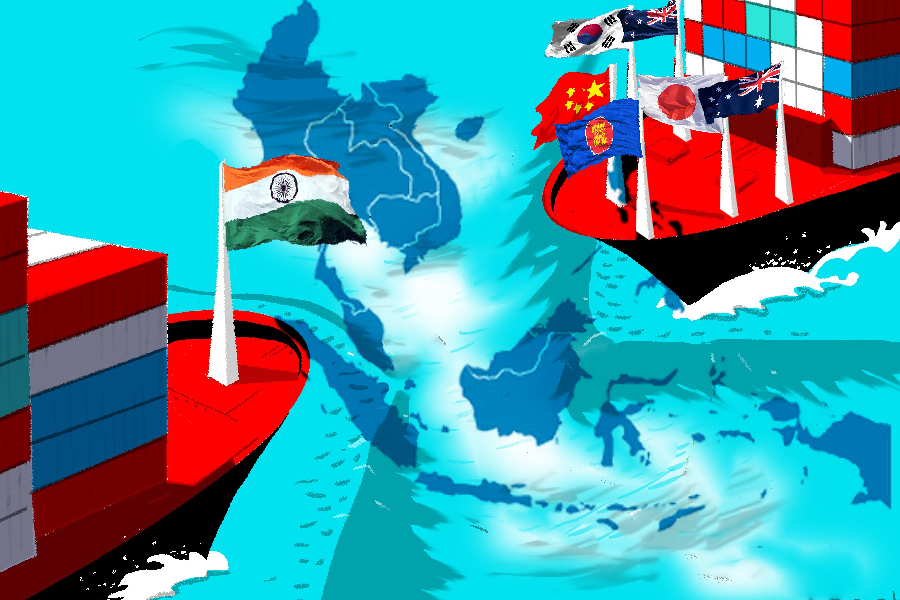
The ASEAN region, which is India’s 4th largest trading partner, includes Brunei, Cambodia, Indonesia, Laos, Malaysia, Myanmar, the Philippines, Singapore, Thailand, and Vietnam. The countries encompassing ASEAN region have a total population of around 662 million people and a combined gross domestic product (GDP) of US$ 3.2 trillion as of 2022.
India signed an FTA with ASEAN (its fourth largest trading partner), known as the ASEAN-India Trade in Goods Agreement (AITIGA), on 13th August, 2009. It got implemented in January 2010, followed by an FTA in services and investments in 2014. However, ASEAN-India trade took over a decade to double in value. India has been particularly concerned with the rising trade deficit trade deficit with ASEAN, which increased to US$ 43.57 billion in the last fiscal from just US$ 5 billion in 2010-11. Ten years after its signing at the 16th ASEAN Economic Ministers – India Consultation 2019, India and ASEAN countries agreed for a review of the FTA.
Shri Rajesh Agrawal IAS, Additional Secretary, Department of Commerce, Ministry of Commerce and Industry, represented India at the 20th ASEAN-India Economic Ministers’ Meeting, which was co-chaired by Dr. Zulkifli Hasan, Indonesian Minister of Trade, on August 21, 2023, in Semarang, Indonesia. The meeting was attended by Economic Ministers or their representatives from all ten ASEAN countries.
During the meeting, India and the ASEAN agreed to review their free trade agreement in goods by 2025. This review aims to address concerns about implementation issues, origin rules, custom procedures, more duty cuts and, data sharing, as well as the widening trade deficit between India and ASEAN region. ASEAN’s interests would be to continue the expansion of export directed towards the Indian market.
“The review of the AITIGA was a long-standing demand of Indian businesses, and the early commencement of the review would help in making trade facilitative and mutually beneficial,” the Ministry said in a statement. “The Ministers agreed to follow a quarterly schedule of negotiations and conclude the review in 2025. The review of AITIGA is expected to enhance and diversify trade while addressing the current asymmetry in bilateral trade,” the Ministry added.
Trade analysts note that the call for this review stems from challenges like uneven FTA concessions, non-tariff obstacles, import regulation, and Quotas, which have impacted India’s exports to ASEAN.
Further the ministers also interacted with the ASEAN-India Business Council (AIBC) and noted the Non-Tariff Barriers (NTBs) flagged by the businesses.
Challenges in India-ASEAN relations
While the trade deficit is a major challenge that has often been covered, a number of issues have been identified that are restricting India from leveraging the full potential of this arrangement. These include:
- Lack of market access and connectivity: Some Indian products do not have market access in ASEAN countries. This is due to a number of factors, such as high tariffs and non-tariff barriers. Despite efforts in this direction, physical and digital connectivity between India and ASEAN countries remains limited, which affects trade, investment, and people-to-people ties.
- ASEAN strict rules of origin: The rules of origin for the India-ASEAN FTA are very strict. This makes it difficult for Indian exporters to export products to ASEAN countries and benefit from the tariff reductions under the FTA. On the other hand there are a number of alleged instances where merchandise is being re-routed from China, via ASEAN countries with minimum value addition, thereby misusing the India-ASEAN FTA.
- Nature of engagement: India still engages with ASEAN countries more on a bilateral basis rather than through a multilateral approach. India’s bilateral approach to ASEAN can lead to problems of coordination and consensus-building. This is because each ASEAN country has its own interests and priorities. This can be a challenge for India, as it seeks to promote its own interests in the region.
- Competing regional agreements: Engagement of ASEAN countries with other regional agreements like the RCEP and the Comprehensive and Progressive Agreement for Trans-Pacific Partnership (CPTPP) diverts attention and resources away from the ASEAN-India relationship.
India’s trade with ASEAN
India’s exports to ASEAN stood at US$ 25.7 billion in 2010-11 up from US$ 18.11 billion in 2009-10. However, imports in 2010-11 rose to US$ 30.6 billion from US$ 25.8 billion in 2009-10. Similarly, in 2022-23, India’s exports to ASEAN increased to US$ 44 billion from US$ 42.32 billion in 2021-22. However, imports jumped to US$ 87.57 billion compared to US$ 68 billion in 2021-22.
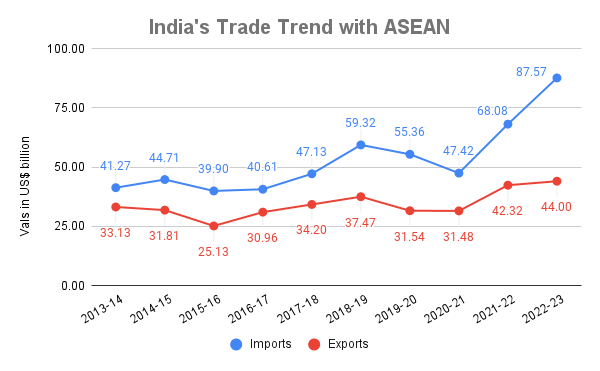
Source: Ministry of Commerce and Industry
The bilateral trade was US$ 57 billion in 2010-11, when the FTA came into effect, and rose to US$ 131 billion in 2022-23. Trade with ASEAN accounted for 11.3% of India’s global trade in 2022-23. The trade deficit has widened to US$ 43.57 billion in the last fiscal from US$ 25.76 billion in 2021-22. It was just US$ 5 billion in 2010-11.
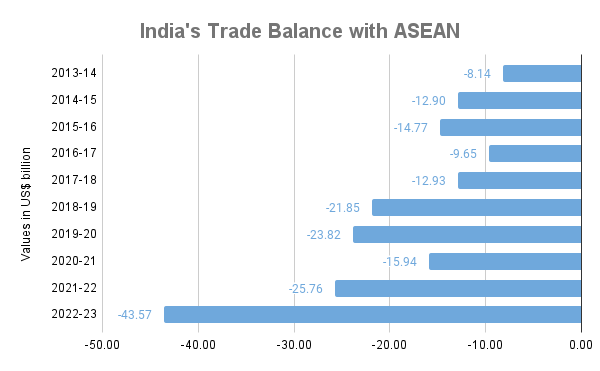
Source: Ministry of Commerce and Industry
This disparity corresponds to the swift expansion of ASEAN’s export and manufacturing capabilities. Multinational corporations have directed investments towards ASEAN as a component of their China-plus-one-strategy.
| Highest Imported Commodities in 2022-23 | ||||
| HS Code | Commodity | 2021-2022 | 2022-2023 | %Growth |
| 27 | Mineral fuels | 11,941.07 | 21,191.10 | 77.46 |
| 15 | Animal or vegetable fats and oils | 9,770.13 | 11,270.60 | 15.36 |
| 85 | Electrical machinery and equipment and parts | 8,159.71 | 10,437.45 | 27.91 |
| 84 | Nuclear reactors, boilers, machinery and mechanical appliances | 6,597.08 | 7,122.41 | 7.96 |
| 39 | Plastic and articles thereof | 3,690.45 | 3,825.91 | 3.67 |
| 29 | Organic chemicals | 3,735.87 | 3,403.24 | -8.90 |
| 89 | Ships, boats and floating structures | 1,161.29 | 3,314.57 | 185.42 |
| 72 | Iron & Steel | 2,379.20 | 3,096.33 | 30.14 |
| 71 | Natural or cultured pearls, precious or semiprecious stones | 1,906.50 | 2,299.51 | 20.61 |
| 38 | Miscellaneous chemical products. | 1,750.42 | 1,820.31 | 3.99 |
Source: Ministry of Commerce and Industry, values in US$ million
India’s imports from ASEAN have been dominated by mineral fuels in 2022-23 and followed by animal and vegetable fat, electronic goods, nuclear reactors, plastic, chemicals, ships and boats, gems and jewelry. The main reason for increase in imports from ASEAN is the steep tariff reductions under the FTA. The tariff reductions under the FTA have made it cheaper for Indian consumers to buy goods from ASEAN countries. Additionally, the adoption of production-linked incentive schemes has intensified the demand for intermediary goods in India for manufacturing.
On the positive side, however, as this research points out, India’s exports of non-oil and non-mineral products have increased in the 10 years post-FTA. Imports on the other hand are dominated by non-oil products like, textiles, electronic goods, chemicals and machinery that are vital to Indian manufacturing. In fact, India’s exports of manufactured goods had a higher share of 39.5% in 2020 as compared to 35.3% in 2010. Interestingly, a number of items put by India in the exclusion list (around 1,297 tariff lines) have seen an increase in imports.
According to Saroj Kumar Datta, VC at Capital University, Jharkhand, the India-ASEAN FTA review is expected to make AITIGA more user-friendly, simple, and trade-facilitating for businesses, as well as support sustainable and inclusive growth. It is also expected to enhance and diversify trade while bringing symmetry to bilateral trade between India and ASEAN countries. It is hoped that the ongoing ASEAN-India FTA review is expected to have a positive impact on the future of ASEAN-India trade dynamics. The review is also expected to boost trade and investment between the two regions, which would create jobs and economic growth and build a multi-pronged strategic partnership, which requires efforts in terms of MRAs, trade facilitation measures and acceptance of standards.








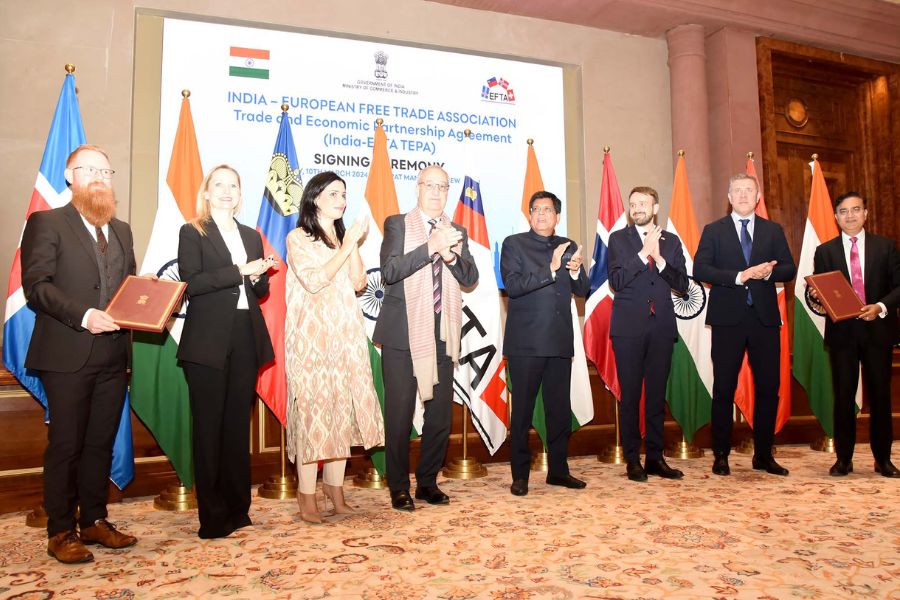
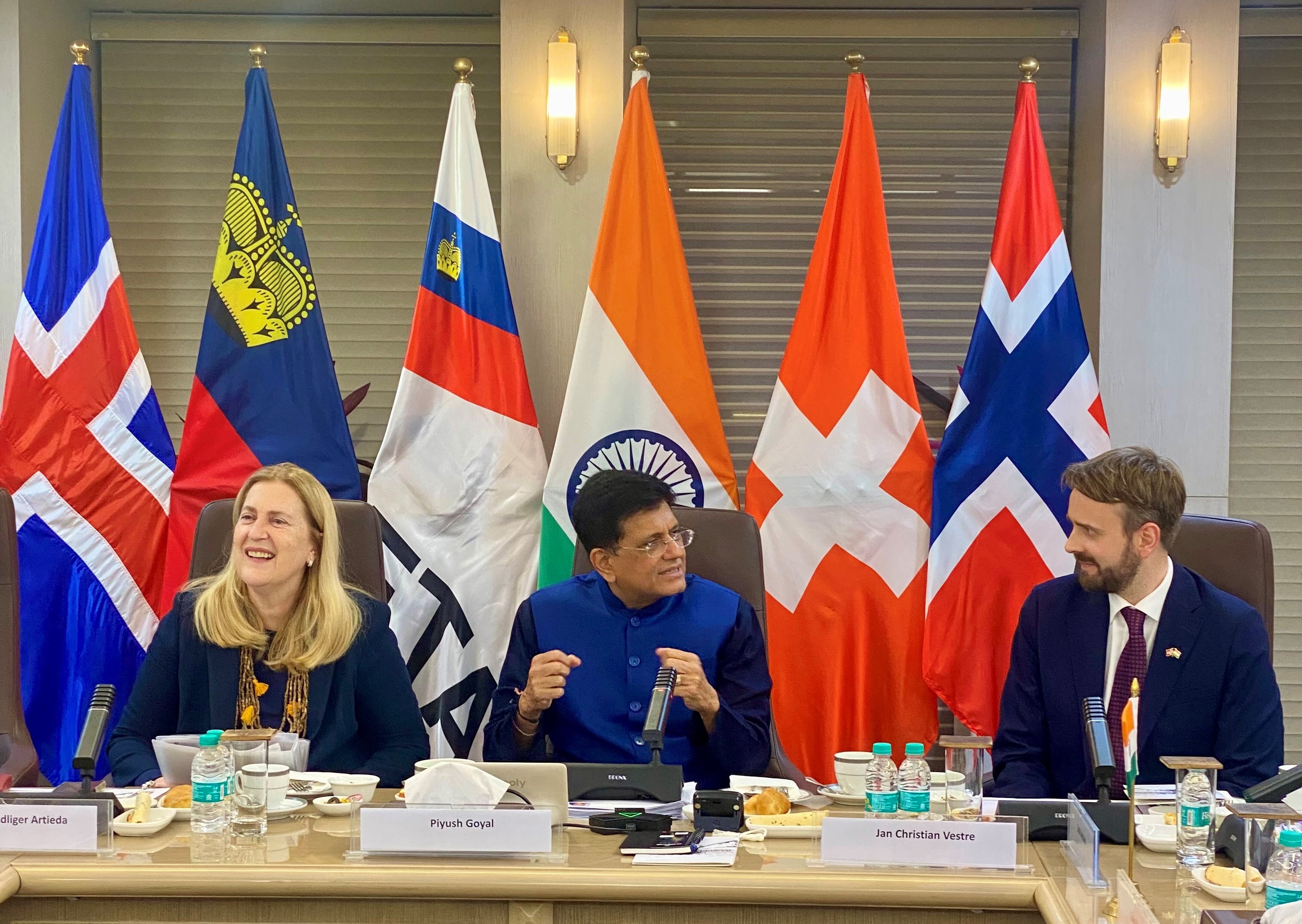
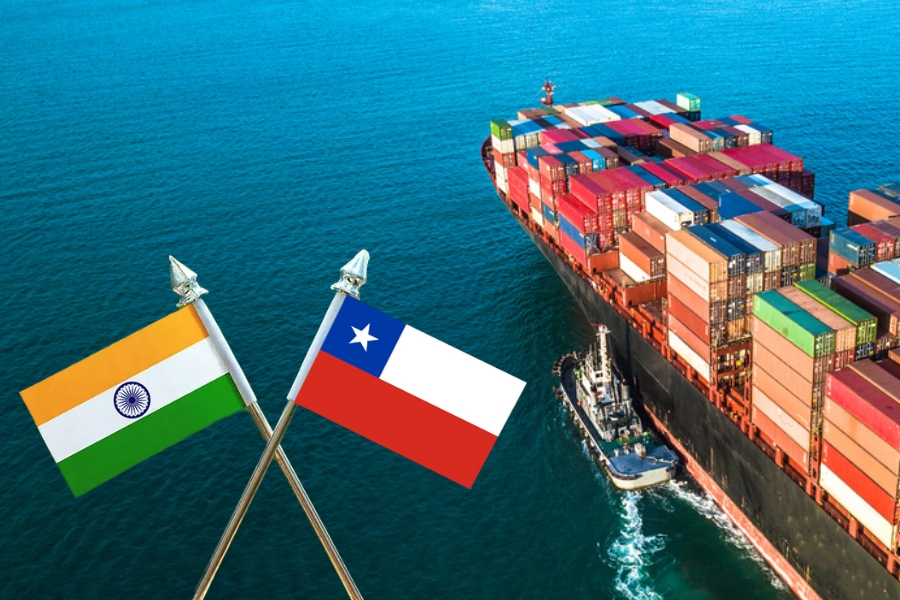
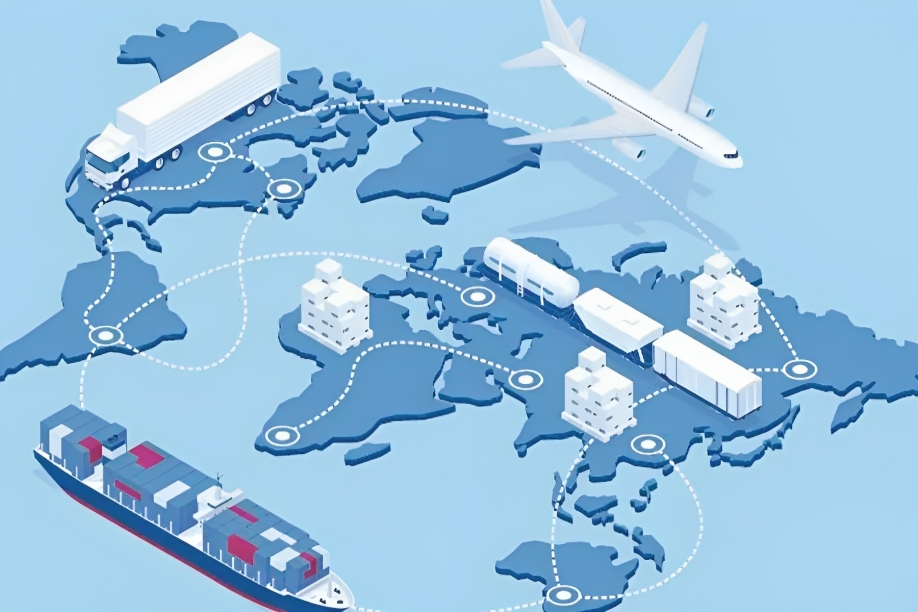

Leave a comment